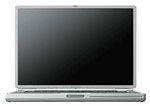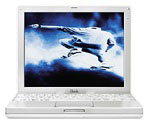Back in May, I noted in Real
World Depreciation that a new computer "loses anywhere from 40% to
50% of its value the first year," yet the IRS believes they should be
depreciated at 20% per year. According to my calculations, my $2,599
PowerBook G4/400 would
be worth $1,500-1,600 in January 2002, not the $2,080 figure the IRS
insists on. (Club Mac is currently blowing out the old TiBook 400 for $1,725.)
I went a step further and said that the real world value of my
TiBook would be somewhere around $1,000 in January 2003 - a far cry
from the $1,560 value IRS depreciation would claim for it.
Apple helped prove my point yesterday by releasing two new
PowerBooks and a faster iBook. And we're not even going to bother
asking the value question - all of these are better values than the
models they replaced.
PowerBook G4/550
The computer that best proves my point is Apple's new "entry level"
TiBook, which runs at 550 MHz  (37% faster
than my G4/400), has a 20 GB hard drive (twice as large as mine), and a
better graphics section for $2,199 - $400 less than the PB G4/400 sold
for in January. Other improvements include gigabit ethernet and a more
compact, square power adapter.
(37% faster
than my G4/400), has a 20 GB hard drive (twice as large as mine), and a
better graphics section for $2,199 - $400 less than the PB G4/400 sold
for in January. Other improvements include gigabit ethernet and a more
compact, square power adapter.
Refurbished G4/400 TiBooks had already dropped below $2,000 before
release of the new model, so there's no way mine is worth anything
close to the $2,080 depreciated figure the IRS believes in. With nearly
nine months of daily use, I'd have to put the current value of my 'Book
(not counting the memory upgrade, which has dropped in value even
faster) at $1,800 tops.
But we're not here to bemoan Moore's Law or deride the IRS (well,
not too much); we're looking at the new PowerBook. In typical Apple
fashion, they make no mention of which G4 chip the new 'Books use, only
that it has an integrated 256K L2 cache. This is in contrast to
the old TiBook, which
had a 1 MB level 2 cache running at half CPU speed.
What remains unknown at the moment is whether Apple using the same
PowerPC 7450 CPU found in the Power Mac G4 or the lower
power consumption 7440. Both include the 256K L2 cache, but I'm
guessing Apple is using the latter to keep power drain down.
The next question is how the G4 inside the new TiBook compares with
the G4 used in the old TiBook. It's the old tradeoff of cache size,
cache speed, and CPU architecture. I'm sure sites such as Accelerate Your Mac, Bare Feats, and Macworld will provide those answers as
soon as they can lay hands on the new models.
Regardless of exact performance figures, the TiBook 550 is an
excellent value. It almost makes me regret buying my TiBook 400
in January.
PowerBook G4/667
While the TiBook 550 offers a nice step up from the older PowerBook
G4, the TiBook 667
seems to offer more of everything: a faster bus, a faster CPU, a larger
hard drive, and twice as much memory. On top of that, the AirPort card
that the rest of the world pays $99 for comes free with this
PowerBook.
Both TiBooks have a build-to-order (BTO) option that replaces the
DVD drive with a CD-RW unit for $100. It's too bad there's no
combination CD-RW/DVD drive that fits the TiBook yet, since road
warriors would then be able to do backup and watch DVDs on the road.
Maybe next revision....
Another BTO option is a 48 GB hard drive. Although Apple's site
doesn't say so, the only drive we know of is the 5400 rpm IBM
TravelStar, which is faster and quieter than the typical 4400 rpm
laptop hard drives.
At $2,999 including AirPort, the TiBook 667 is an impressive value
if you don't find the 550 MHz model fast enough for your needs.
iBook (600 MHz)
In our haste to post new iBook profiles yesterday, we got two things
wrong. The entry-level iBook remains at 500 MHz with a 66 MHz bus,
retains the $1,299 price, and now includes  128 MB of memory and a 15 GB hard drive. Also, Apple has
not discontinued the CD-RW option for the iBook. We've updated
our profiles to reflect this.
128 MB of memory and a 15 GB hard drive. Also, Apple has
not discontinued the CD-RW option for the iBook. We've updated
our profiles to reflect this.
The entry-level 500 MHz
iBook is essentially a revision of the old model; we want to look
at the new 600 MHz iBook.
Not only is the CPU faster, so is the bus. Between a 20% faster
processor and a 50% faster bus, the new iBook should hold its own
against the TiBook 550 for anything that doesn't use the G4's Velocity
Engine.
The three iBook configurations are value-priced at $1,499 with DVD,
$1,599 with CD-RW, and only $1,699 with the combination CD-RW/DVD
drive. The last price represents a $100 drop from the old iBook with a
Combo Drive. As we said earlier, there's no question that all the new
models are better values than the ones they replaced.
The DVD and CD-RW models include a 15 GB hard drive, while the Combo
Drive machine ships with 20 GB. You can build-to-order with a 15, 20,
or 30 GB hard drive, and if you want to save a little money, you could
get a Combo Drive iBook with a 15 GB drive and save $50. (It's too bad
Apple doesn't offer the high capacity, high performance 48 GB drive
with the iBook.)
As with the TiBook, Apple doesn't specify with version of the G3 is
used in the new iBook. Although the previous iBook used the PowerPC
750CX, we suspect this may be the 750CXe or possibly even IBM's
just-announced 750fx.
Closing Thoughts
We remain frustrated with Apple's failure to go beyond the G3 and G4
labels and specify anywhere on their site just which version of the G3
and G4 are being used inside their computers. This goes for desktops as
well as portables. Although not of interest to the average user,
there's no reason to withhold this information from tech savvy Mac
users.
If you don't need the extra speed provided by the new models,
there's no time like the present for buying a discontinued TiBook or
iceBook at a bargain price. That said, I believe the new iBook provides
a significantly better value than a close-out price on the old iBook,
assuming you can even find one.
The TiBook 400 remains a good value at close-out prices in the
sub-$1,800 range, but given the choice between roughly $2,000 for the
TiBook 500 and $2,200 for the new TiBook 550, the new model is the
better value.
It's a shame nobody makes a combination CD-RW/DVD drive that fits
the TiBook. Give it time. Someone will eventually make one.
Although the fast, quiet 48 GB drive for the TiBook is tempting,
Apple gets a $400 premium (vs. the 20 GB drive in the TiBook 550) for a
drive that sells on the open market for about $350-400. Weighing the
time involved to swap out drives, the small difference in price, and
the potential value of the pulled 20 GB hard drive, it's pretty much a
wash whether you do it yourself or have Apple install the drive. From a
convenience standpoint, the build-to-order option wins hands down.
Apple has improved some excellent portables that were already good
values, making them more attractive than ever. At these prices, they're
not only great portable computers, but also compelling alternatives to
iMacs and Power Mac G4s for anyone who might ever have a reason to use
a Mac on the go.

 (37% faster
than my G4/400), has a 20 GB hard drive (twice as large as mine), and a
better graphics section for $2,199 - $400 less than the PB G4/400 sold
for in January. Other improvements include gigabit ethernet and a more
compact, square power adapter.
(37% faster
than my G4/400), has a 20 GB hard drive (twice as large as mine), and a
better graphics section for $2,199 - $400 less than the PB G4/400 sold
for in January. Other improvements include gigabit ethernet and a more
compact, square power adapter. 128 MB of memory and a 15 GB hard drive. Also, Apple has
not discontinued the CD-RW option for the iBook. We've updated
our profiles to reflect this.
128 MB of memory and a 15 GB hard drive. Also, Apple has
not discontinued the CD-RW option for the iBook. We've updated
our profiles to reflect this.
